We use cookies to improve your experience. By accepting you agree to our cookie policy

For many, Complex Regional Pain Syndrome (CRPS) can feel like a life sentence, especially when the pain becomes unbearable, and the light in their eyes starts to dwindle. However, following the massive support of the summer 2016 Paralympics in Japan, the popularity and the sight of amputee athletes using prosthetics has given sufferers of this terrible neurological disease a sense of hope.
As a CRPS charity, Burning Nights is often asked, “Is Amputation A Cure For CRPS?”. Such a life-changing decision requires a lot of consideration, especially since CRPS has the potential to reoccur.
The possibility of developing phantom limb pain following the amputation is high, especially for those suffering from CRPS; this may also make a prosthesis impossible to use, as they cannot even tolerate putting it on.
Amputation for Complex Regional Pain Syndrome remains highly controversial, even if the treatment method is for this therapy-resistant syndrome (Bodde, M.I. et al. 2011).
Several high-profile cases of CRPS amputations have occurred over the last few years, leading to other patients hoping to take a similar course of action.
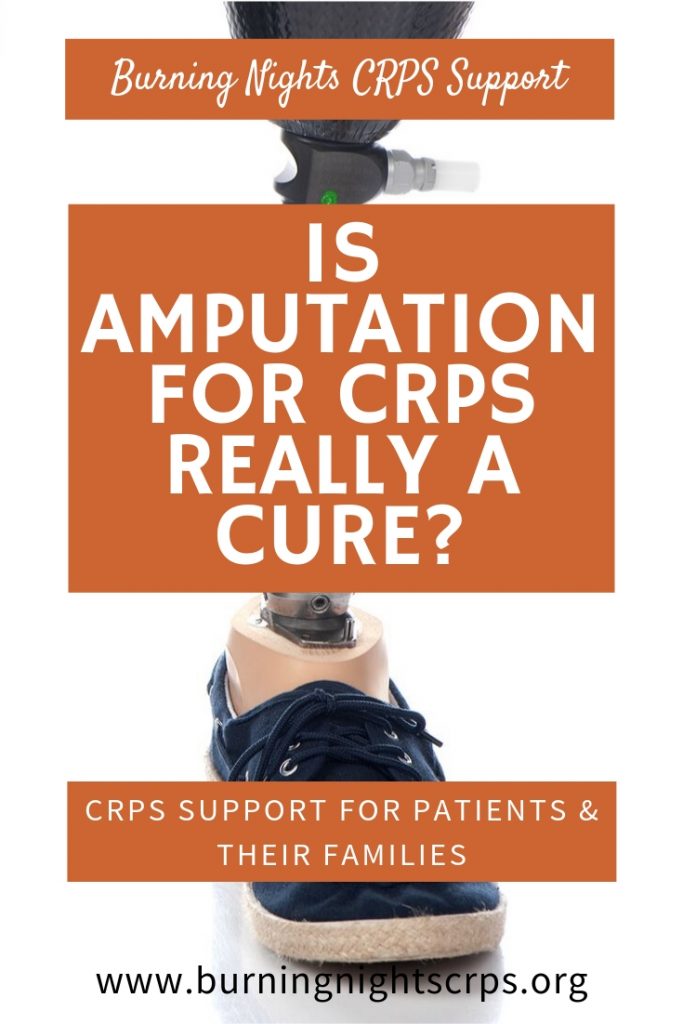
This chronic syndrome can be debilitating and resistant to the range of available verified treatments. Amputation is always considered a last resort for this syndrome, if it is even considered in the first place (Hohendorff, B. et al. 2011).
Medical professionals often tend to err on caution regarding amputation, even in the most severe exceptions. This is usually because very little evidence is available to support this option for CRPS.
We would recommend that all alternative options be explored for pain control and dysfunctional limb treatment before amputation of the CRPS affected limb or extremity is considered.
However, if a patient has long-standing and therapy-resistant CRPS Type 1, then amputation can be justified (Kashy, B.K. et al. 2015). In a case report by Finlayson, H & Travlos, A. (2003), it was stated that consideration might be given to amputation in patients with CRPS if the disease has plateaued and there is a clear indication for improvement of residual function rather than pain relief.
The main aim of amputation is to increase the quality of life and mobility and decrease pain intensity (Bodde, M.I. et al. 2014). In a 2019 study by Ayyaswamy (B et al.), it was concluded that 66% of the people they studied had improved their quality of life after the amputation.
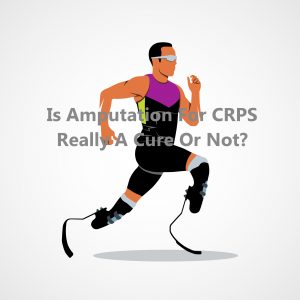
Additionally, the decision-making process for this method is very different from that of amputation due to cancer or vascular disease. In the latter cases, it may be a life-saving option and the only obvious choice, whereas surgeons may have difficulty removing a viable limb with CRPS.
However, it is essential to remember that life with pain and a dysfunctional limb may be even more disabling.
If you have tried multiple treatments without success, you may believe that amputation is your only option, and you may even think that amputation could provide a better outcome for you. However, you must remember that amputation only increases the risks of new problems.
Guidelines advise against performing amputations for CRPS, and informed decision-making is a team process involving health care professionals and you, the patient.
Pre-amputation counselling is sometimes provided for patients who have chosen to undergo amputation; a psychological assessment is occasionally requested by the multi-disciplinary team involved.
Due to the media attention directed toward various CRPS patients who have either performed a self-amputation on themselves or have gone on to have an amputation for CRPS, the Royal College of Physicians has included amputation for CRPS in their complex regional pain syndrome guidelines, which was updated in July 2018.
It is stated within the guidelines that a multi-disciplinary team (MDT) must be involved before a referral for a CRPS amputation can be made. That MDT must, as a minimum, include the following professionals:
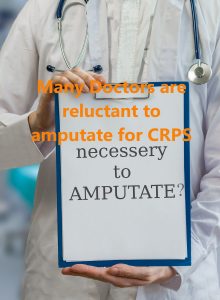
According to the guidelines, amputation may be considered after other evidence based options have failed (Bodde, M.I. et al 2014).
If amputation is considered at some stage by your medical team, it is essential that your intentions are understood in a bid to make a positive difference in post-amputation problems (Bodde, M.I. et al. 2014).
It is normal for a CRPS patient to want to have their affected limb amputated, and this is believed to be caused by body perception disturbance (BPD). BPD is when a patient’s visualisation of the affected limb is distorted.
With BPD, you may envisage your limb as bigger, longer or in a different position to what it is. Our thoughts and feelings about the affected limb are altered because of the levels of pain we feel. BPD is ubiquitous in patients and is becoming more recognised as a symptom of Complex Regional Pain Syndrome.
"Patients with CRPS commonly report that the affected limb is psychologically 'detached' from the remainder of their unaffected body (a sense of disowning) such that it feels alien and outside of their control.
"An extreme form of detachment is expressed by some as a desperate desire to amputate their limb. Despite under-standing clinical opinion advising against amputation, some patients continue to express this intense urge to amputate the limb and can commonly describe, in some detail, how they plan to get rid of it." (Lewis JS, Kersten P, McCabe CS, McPherson KM, and Blake Dr, 2007)
One piece of research in 1995 studied limb amputation of patients with Complex Regional Pain Syndrome and concluded that most were still enduring significant pain and could not wear a prosthesis.
"Limb amputation was studied in 28 CRPS patients after 34 amputations of 32 limbs. This had been performed for untenable pain, recurrent infection, or to improve residual function. Only two patients were relieved of pain by amputation. In 28 amputations, CRPS recurred in the limb stump. Only two patients could wear a prosthesis." (Dielissen, 1995)
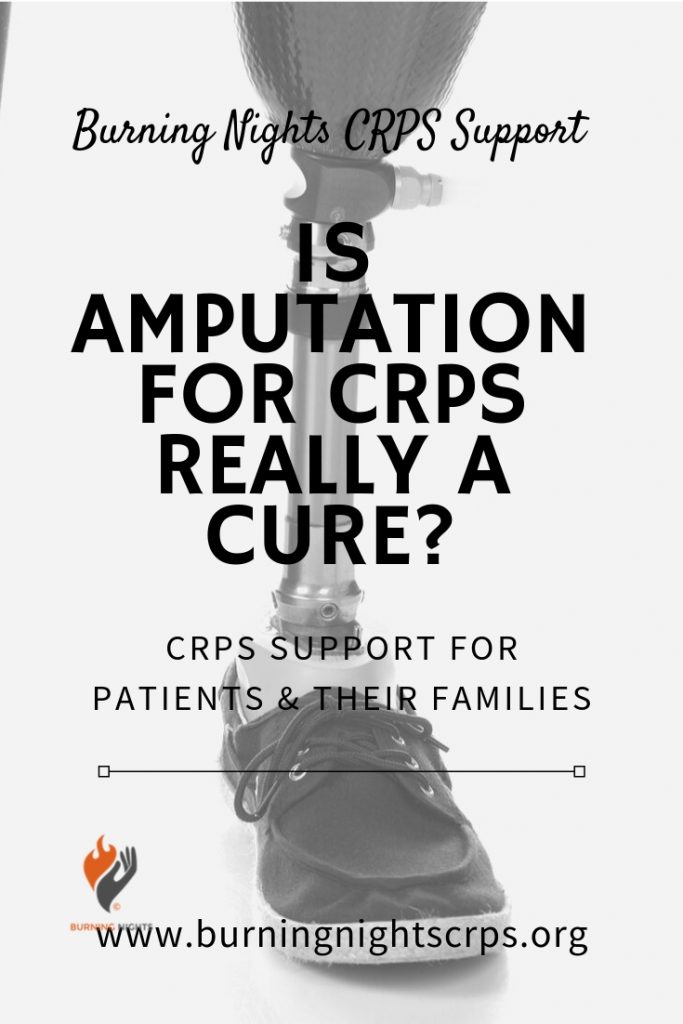
The Dielissen study determined that pain relief was rare, and recurrence of CRPS was frequent within the stump, preventing the use of prosthetics. Additionally, amputation to increase residual function or for severe incurable infection was not universally successful (Pagoti, R. et al 2007).
It was concluded that amputation in Type I patients should only be performed to increase residual function or to relieve severe incurable infections. There is no guarantee that symptoms will cease once the affected limb is removed.
Three main types of pain have since been reported; recurrent CRPS with pain in the stump, pain in the stump without CRPS and phantom limb pain. The risk of phantom limb pain is high, but there is no certainty that the removal has been carried out above the level of the CRPS.
Many pain consultants seem to believe that in the case of severe CRPS, the risk of recurrence of the CRPS in the amputation stump is exceptionally high, possibly as much as 50%.
Midbari M. et al. (2016) concluded that none of the 19 amputees was pain-free; the most prevalent pain was phantom limb pain in 89%, followed by 42% who had pain in the stump, and 32% of the group had recurrent CRPS in the amputated limb. Most patients had more than 1 type of pain, and just 10% resumed employment.
In another study by Bodde, M.I. et al. (2014), 72% of amputees with Complex Regional Pain Syndrome experienced phantom limb pain within the first three months. After one year, they found 86% experienced phantom limb sensations, 71% experienced residual limb pain with a wide range of frequency and disability and 27% had the syndrome reoccur after 1-year post-operation.
However, although research has shown that many CRPS patients react badly regarding the recurrence of pain, they were often relieved that the affected limb was gone and was not part of them anymore. As we mentioned earlier, people considering amputation often say they no longer believe the affected limb to be a part of them.
It is explained how this course of treatment may be seen as a chance to get rid of their limb which they see as useless. Instead, this can make the pain worse than it was prior to amputation (Bodde, M.I. et al 2011). Alternative treatment methods should be favoured due to the high risks attached to limb removal.
Guidelines support this method as a treatment only in the presence of therapy-resistant infection that cannot be cured by antibiotics. In general, guidelines warn against amputation because of the high occurrence of CRPS and poor use of prosthesis (Bodde, M.I. et al 2014).
There is not only pain, phantom limb pain or sensation and CRPS to consider when considering amputation; Szeinberg-Arazi et al. (1993) also reported that patients with a post-CRPS amputation also require psychological support.
"Patients with intractable pain in a limb due to CRPS type I may enquire about amputation to ridding themselves of the severe pain and useless limb. Although this may successfully relieve the pain, there is a substantial risk that amputation of a painful limb will lead to the development of stump and phantom limb pain of CRPS, or even worse. Attempts at pain relief and restoration of function are preferable to amputation." (Krans-Schreuder, Bodde, Schrier, et al. 2012).
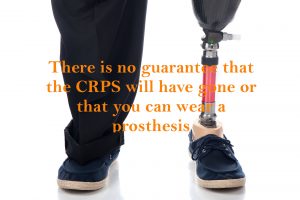
According to Rowbotham, M.C. (1998): "Amputation is not to be recommend as pain therapy. All 11 patients in our series of 824 CRPS patients who underwent Amputation showed marked deterioration post-op.
"The surgical stump was the source of multiple neuromas with sever CRPS II type of intractable pain. Amputation should be avoided by all means due to its side effects of aggravation of pain and tendency for spread of CRPS."
The risks are very high, and only a small minority are free of Complex Regional Pain Syndrome; you could be left with considerable pain following the removal of the limb. Furthermore, you may not be able to use a prosthesis, meaning mobility could decrease even further.
Most research has had poor patient outcomes and clearly shows the level of risk this procedure carries.
Due to these research outcomes and specialist opinions, many physicians are unlikely to agree to amputation unless mitigating circumstances exist.
"At this time, there is no research to support amputation as a cure for CRPS, and with the unknown true pathology of CRPS, the extent of peripheral versus central neuropathic pain, amputation may be of no benefit and may lead to more pain and decreased functions outcomes." (Cristian, A. 2014)
Unfortunately, pain specialists are sometimes reluctant to even discuss this procedure for Complex Regional Pain Syndrome (Midbari, A. & Eisenberg, E. 2017). As Midbari, A. & Eisenberg, E. (2017) states: “Thus, at least some patients with “end-stage” CRPS remain hopeless, helpless, and cureless with regards to pain and function.”
What is most certainly obvious is that more research is needed to help determine which patients may benefit from this course of action. (Kashy, B.K. et al 2015).

In conclusion, amputation for CRPS is highly controversial due in part to the potential for worsening or recurrence of CRPS symptoms and phantom limb pain.
Although not considered a cure by any means, amputation may be contemplated as a last resort if there are recurring infections, CRPS is long-standing, retractable and therapy-resistant (Kashy, B.K. et al. 2015; Midbari, A. et al. 2016; Krans-Schreuder H.K. et al. 2012). Additionally, there is insufficient evidence that amputation could positively contribute to CRPS treatment (Dielissen et al.1995, Stam et al. 1994).
In the case study by Goebel A. et al. (2018), the current evidence doesn’t support the use of amputation for CRPS to improve pain or function. As in this case study and the RCP CRPS Guidelines (2018), before a decision is made, in exceptional cases, about referral for amputation, Dorsal Root Ganglion (DRG) stimulation can be undertaken.
This CRPS amputation blog has been written by both Lisa, 1 of Burning Nights CRPS Support’s trustees who is an above knee amputee and also by the charity’s Founder Victoria Abbott-Fleming who is a bilateral (double) above knee amputee due to the aggressive symptoms of CRPS.
If you would like to talk to our founder, Victoria about amputation please either ring our helpline on 01663 795055 or email Victoria direct.
Last Updated: 15/08/2023
We use cookies to improve your experience. By accepting you agree to our cookie policy
 £
£